by W.S. Cranshaw and F.B. Peairs* (1/17)
Quick Facts…
- Many kinds of flies can be found indoors. Some of these flies only temporarily use buildings for shelter while other flies may reproduce indoors.
- Flies that use buildings as temporary seasonal shelter, such as cluster flies and bluebottle flies, are best managed by sealing buildings prior to periods when they move to buildings in late summer and early autumn.
- Some flies, particularly the smaller flies, can reproduce in homes feeding on items such as overripe fruit, fungi in the soil of houseplants, or in material found in drains.
- Eliminating food sources used by developing flies is an important step to take to limit problems with flies that can breed within a building.
- Screening, caulking and other methods that exclude flies is important in limiting problems that temporarily used buildings for shelter, such as cluster flies.
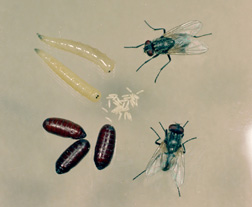
Figure 1: Life stages of the house fly. (Photo courtesy Clemson University.) |
Several kinds of flies may be found within homes and buildings in Colorado. Most are transients that do not reproduce indoors but move from outdoor sites to buildings, often while seeking protected sites for shelter during the cool months. Some can breed indoors, developing in sites such as overripe fruit (e.g., vinegar/small fruit flies), in soil of houseplants (e.g., fungus gnats), within drains (e.g., moth flies, humpbacked flies), or in moist garbage. The flies found indoors often are merely nuisance pests, although those that develop in manure, carrion, and garbage may be contaminated with disease-causing bacteria, including those associated with food poisoning.
The most commonly observed stage of any type of fly is the winged, adult stage. The immature stages (larvae) are in the form of pale, legless maggot. When full grown, the larvae usually wander a bit away from their breeding site than transform to a different stage, the pupa. Further changes occur during the pupal stage, with the adult form ultimately emerging. Many flies can complete a cycle of this development (egg, larva, pupa, and adult) in a short period, a week or two, and produce many generations a year (Figure 1). On the other hand, some flies found in homes during the winter may be in a dormant condition and will remain in the adult form for many months without reproducing.

Figure 2: Black blow fly |

Figure 3: Bluebottle fly |

Figure 4: Cluster fly |
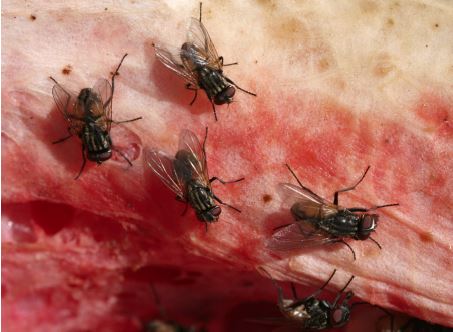
Figure 5: House flies feeding on a ripe melon. |
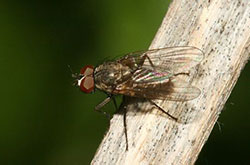
Figure 6: Little house fly. (Photo courtesy of David Shetlar, Ohio State University.) |
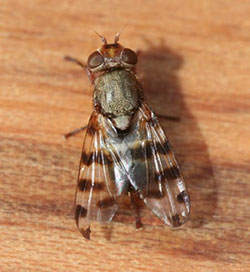
Figure 7: Ceroxys latiusculus, a picturewinged fly that commonly enters buildings in autumn. |

Figure 8: Fungus gnat on a soil surface. |
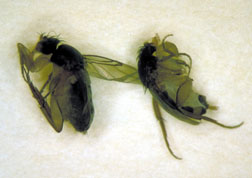
Figure 9: Fungus gnat on a sticky card. |
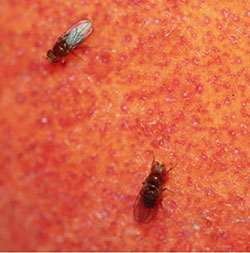
Figure 10: Small fruit flies (“vinegar flies”) on the surface of an overripe peach. |
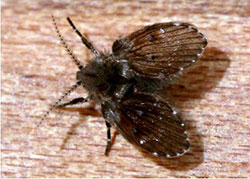
Figure 11: Moth fly. |

Figure 12: Adults of the humpbacked fly Megaselia scalaris. |
Common Flies Found in Buildings
Blow Fly
The blow flies found in buildings are fairly large, metallic gray, blue or black flies. Common species include the black blow fly (Phormia regina) and various bluebottle flies (Calliphora species). Normally these flies breed outdoors, but during the cool season they seek out sheltered areas, which often include buildings. Bluebottle flies and the black blow fly do not go into full winter dormancy and not only may become active during warm periods in winter and early spring, but are also capable of laying eggs and reproducing if conditions are favorable. These blow flies are scavengers, particularly of animal-based materials. They commonly breed in carrion or pet waste.
The presence of large numbers of blow flies within a home may be due to several reasons. During late fall and winter large numbers of flies indicate that there were several accessible entry points when they were seeking winter shelter in fall. These flies may also be attracted to gas leaks, and are very sensitive to odors produced by the decomposition of a recently dead animal.
On rare occasion one might encounter large numbers of blow flies breeding on a dead animal – usually a mouse or squirrel – that has died behind the walls of a home. Sometimes the presence of these flies is preceded by observations of migrating maggots, which wander from the carcass after they are full grown. Although such occurrences are unpleasant, they are usually short-lived and self-limiting, as the insects are only capable of breeding on freshly killed animals.
Cluster Flies
Cluster flies (Pollenia species) are often the most common fly found in homes during the cool months and are particularly abundant in higher elevation areas of the state. They can sometimes be serious nuisance problems, particularly in taller buildings where they tend to concentrate on upper stories on the south and west sides. Cluster flies are moderate sized, generally dark gray and are distinguishable by the presence of golden hairs on areas of the thorax.
Cluster flies are actually a type of blow fly, but have very different habits than the bluebottle flies and black blow fly. They are not a type of “filth fly” that develop as a scavenger, but instead are parasites of earthworms. In spring and summer the adult flies are present in lawn areas, where they lay eggs on the soil in sites where earthworms are present. When eggs hatch, the tiny larvae of the cluster flies burrow into the soil to seek an earthworm on which they will feed.
Cluster flies survive winters in the adult stage, but in a semi-dormant condition (diapause) during which time they neither feed nor reproduce. In late summer and early autumn they may be seen sunning themselves on sun-exposed sides of buildings during warm periods. Many of these will move into cracks and crevices of the building, seeking cavities behind walls as a protected sites to spend the winter months. In the process of seeking these sheltering sites within the building they tend to migrate upwards, and thus are found most abundantly in upper floors of buildings.
During the cool season cluster flies normally remain inactive, resting in cavities behind walls, often in large clusters. Some flies may become active during warm periods, move about a bit and may then incidentally wander into living areas, where they may be seen flying lazily about a room. However, cluster flies do not feed nor reproduce within buildings and those that move out from their sheltered sites behind walls will usually die within a couple of weeks.
House Fly
The house fly (Musca domestica) is the best known of the house-infesting flies but is generally not the most common species found in buildings in Colorado. House flies generally are gray, with the thorax marked with broad dark stripes. Most often there is some yellow coloring along the sides.
House flies usually are found where humans are present. Larvae commonly develop in or near man-made sources of food and can be found in garbage, animal waste, culled fruits and vegetables, and spilled animal feed. The adult flies feed on a wide range of liquid waste but can eat solid foods, such as sugar. To digest solid foods, house flies liquefy food by regurgitating it. Because of this habit, house flies can pose serious health threats by mechanically transmitting disease organisms. During mild winters, house flies may fly and breed continuously, as temperatures permit.
Little House Fly
Little house flies (Fannia species) are smaller than house and face flies but similar in appearance. Indoors, they fly for long periods and rarely rest. The adult flies lay eggs in decaying organic matter, particularly decaying animals or very moist manure, where the maggot-stage larvae feed. The presence of large numbers of little house flies are most often associated with sites where poultry and livestock are being raised.
A Picturewinged Fly
Ceroxys latiusculus is a fly of house fly size that has distinctive dark band patterning on its wings (“picture wings”). In some areas they are a common invader of homes in early autumn, often found around windows. However, unlike cluster flies, Ceroxys latiusculus does not survive indoors through winter and those that do enter buildings usually are all dead by the end of November. Larvae of this picturewinged fly develop within the stems of Senecio, which include several native plants in the aster/sunflower family.
Fungus Gnat
Fungus gnats are small, dark flies most often found collecting around windows during fall and winter. Fungus gnats can be found indoors infesting potting mixes used for houseplants or hopping across the soil surface. High organic matter plant mixtures and organic fertilizers, such as fish emulsion, encourage fungus gnat development. Overwatering, a common problem during fall and winter, increases fungi and fungus gnat development. Fungus gnats can reproduce on indoor plants and cause little if any damage. They also occur outdoors where they breed in mushrooms and other decaying plant materials.
Small Fruit Flies/Vinegar Flies
Small fruit flies, also known as vinegar flies, are among the smallest flies found in homes (2.0-2.5 mm). They usually are light brown and the most common species have bright red eyes. The larvae develop feeding on yeasts and within a home they are most often found associated with overripe fruit. Other sources of fermenting materials that support growth of yeasts, such as residues present in the bottom of unwashed beer or beverage containers, are other common sites where small fruit flies will breed. They are also readily attracted to open bottles of wines, beer and vinegar. Populations tend to be greatest in late summer and early fall as they infest fruits during the harvest season and then are moved indoors.
Moth Flies
Moth flies, sometimes called “drain flies” or “filter flies”, are occasional problems in homes, most often seen in and around drains of sinks and bathtubs. The adults are very small flies (2 mm), often grayish and superficially resemble a tiny moth. The larvae develop by feeding within the gel of bacteria that often coats the inside of continuously wetted plumbing. Moistened filters of swamp coolers, fish tanks and other similar sites may also be breeding areas of moth flies. Large numbers of the flies can be produced where there is a problem with broken or leaking drain pipes. There can be many areas outdoors where moth flies can breed outdoors and these may be attracted outdoor lighting.
Humpbacked Flies/Phorid Flies
The humpbacked flies, also known as phorid flies, are another type of “drain fly” that may be associated with plumbing. In general size (3 mm) and appearance they somewhat resemble a small fruit fly, but can be distinguished by the large humped thorax when viewed from the side. Larvae of humpbacked flies can develop by feeding on an extremely wide range of moist, decaying organic materials including garbage, dead animal matter, and even some paints. Those that occur indoors are often breeding in food waste associated with drains.
Management of Indoor Flies
Sanitation
The most important first step to manage almost any type of fly that may be found indoors is to eliminate the sources of food on which they develop. This will prevent additional breeding of the flies, although adults that are already present may remain for a week or more, until they die out.
Where small fruit flies (vinegar flies) are a concern this often involves either consuming, covering, or storing all susceptible fruit in a refrigerator for at least a week, until the remaining adult flies have died out. Any discarded fruits/vegetables should be promptly disposed of outdoors. Used beverage containers should be thoroughly washed before being discarded and are best stored outdoors during outbreaks. Food residues that may collect on the bottom of waste containers also should be washed.
House flies, little house flies, and blow flies can breed in many types of moist garbage. They are also capable of developing rapidly, particularly with warmer temperatures. Garbage containers should be covered to prevent access by flies within the building and then should be regularly removed to covered outdoor storage for disposal. Removal of household garbage may need to be done as often as every 4 to 5 days during summer to prevent flies from successfully breeding within a home.
To control fungus gnats, allow the soil of houseplants to dry thoroughly between watering and eliminate decomposing plant materials. This reduces the amount of fungi where fungus gnats breed. Some insecticides are also available to control fungus gnat larvae breeding in soil of houseplants. Certain formulations of the biological control bacterium Bacillus thuringiensis var. israelensis (Gnatrol®, Mosquito Bits®) are often sold at nurseries or garden centers for this purpose. (More information on fungus gnats and their control is found in Fact Sheet 5.584, Fungus Gnats as Houseplant and Indoor Pests.
Moth flies and humpbacked flies that are breeding within plumbing can be controlled by eliminating the bacterial gel coat or lodged food waste that supports these types of flies. This may be done by thoroughly scraping the pipes and drains with a brush. Drain cleaners formulated to remove these materials can also be used to clear plumbing. Cleaners that are effective for this purpose often include enzymes and are formulated as a foam that can allow persistent contact to allow them time to effectively break down and eliminate the food sources that coat the plumbing. Pour down drain cleaners, such as lye, and hot water do not do a good job of eliminating this material and kill few, if any, of the flies developing in plumbing. These “drain flies” also may develop in sites where there are drips or cracks in plumbing or where water may condense and moisten areas behind walls or under floors. If this occurs then these moisture sources must be corrected and the area allowed to dry out.
Exclusion
Screening and other exclusion techniques can be important steps to take to limit several types of indoor fly problems, particularly with flies that develop outdoors and use homes for temporary shelter. Tight fitting screens can prevent indoor access by many flies. However, cracks and crevices around windows, under soffits, and around ventilation openings are common sites that allow flies to work their way behind walls and later enter living areas. These openings must be sealed before flies enter buildings. For example, cluster flies rarely are found indoors until late winter and spring but typically enter buildings during late August and September. To prevent later problems with cluster flies and other “winter flies” all sealing/caulking activities should be done by the end of August, before these insects start to filter into cavities behind walls for winter shelter.
Exclusion can also involve methods that prevent flies from accessing foods. Sealing garbage cans, tightly covering foods and beverages, or storing susceptible foods in a refrigerator can be useful for limiting flies that breed in these materials.
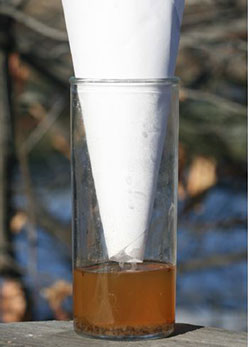
Figure 13: A homemade small fruit fly trap, baited with cider vinegar. |
Trapping
Traps are available that can capture some, but not all, of the kinds of flies that can be found in homes. If traps do exist they are used in combination with other management methods – sanitation and/or exclusion. Used alone, no kind of fly trap will provide satisfactory control.
Perhaps most widely used are traps to capture small fruit flies, as these traps can be easily and cheaply made. Many types of baits can be used that are highly attractive to the adult flies, including cider vinegar, red wines, and mashed banana/beer mixtures. When such baits are placed in the bottom of a jar with a paper cone over the top large numbers of small fruit flies can be trapped for disposal. Commercial traps based on the same principles are also available from many hardware stores and some nurseries.
Various food-based “fly traps” also are for sale, usually in the form of some sort of jar with a cone at the top. Various lures are used to attract the flies and the type of lure used is critical for how well they capture flies. For example, lures used for house flies often have some sugar/yeast based bait while blow flies are often more attracted to baits that have a protein-base or ammonium carbonate.
Some flies are attracted to lights, such as moth flies, humpbacked flies and house flies. Lights that produce wave lengths most attractive to these insects can be used to capture flies on a sticky surface or to electrocute them. The latter designs, known as “bug zappers”, often cause many insects to break apart, scattering body pieces that can contaminate the area near the trap. Because of this bug zapper traps should never be used near areas where food is prepared or consumed.
Sticky strips of “fly paper” has long been used to control house flies. This type of trap is effective for house flies because of their habit of moving to vertical surfaces to rest. Fly paper strips usually catch few of the other kinds of flies that can occur indoors.
Some chemicals have been shown to have some repellency to flies. As with the chemicals used for as attractants the effect of various repellents varies greatly depending on the species of fly.
| Table 1:Common flies that occur in buildings and their management. | ||
|---|---|---|
| Fly Species | Scientific Name | Controls |
| Black blow fly Bluebottle flies |
Phormia regina Calliphora species |
Tightly seal garbage containers and regularly remove animal manure from areas Bluebottle flies Calliphora species around the home. Screen windows in summer and seal areas around windows. Use fly paper or fly traps. |
| Cluster flies | Pollenia species | By early September, caulk and seal all openings around windows and other sites where overwintering flies may enter homes. Give particular attention to entry points on south and west sides near the top of the building. Desiccant (drying) dusts can be blown behind walls to help kill flies before they move into living areas. |
| House fly | Musca domestica | Screen windows. Reduce outdoor breeding sites (decaying plant matter). Fly traps may supplement control. |
| Little house fly | Fannia species | Screen windows. Reduce outdoor breeding sites (primarily decaying animal matter and animal waste). Fly traps may supplement control. |
| Picture-wing fly | Ceratoxys latiuscula | Picturewing flies are harmless, minor nuisance pests that move into buildings in autumn. Preventive practices that restrict other flies from entering homes will also prevent these flies from occurring indoors. |
| Fungus gnats | Bradysia species | Reduce watering of house plants to allow increased drying and limit development of soil fungi on which larval stages feed. Discard rotting or decaying plant materials. Some insecticides (including Bacillus thuringiensis var. israelensis) can be applied to houseplant soil to kill larvae. |
| Vinegar flies/Small fruit flies | Drosophila species | Remove all sources where breeding can occur, including overripe fruit and fermenting materials (e.g., stale beer or soft drinks). Vinegar/red wine baited traps can capture many adults. |
| Humpbacked fly/Drain fly | Megascelis scalaris | Thoroughly clear drains through a combination of mechanical scrubbing and drain cleaners to effectively remove all semi-solid food material lodged in drains. If problems are related to plumbing leaks/breaks then these need to be corrected. |
| Moth flies/Filter fly | Psychoda species | Mechanically scrub and/or use drain cleaners to remove the bacterial gel coating of plumbing within which this insect breeds. If problems are related to plumbing leaks/breaks then these need to be corrected. |
*Colorado State University Extension entomologists and professors, bioagricultural sciences and pest management. 11/99. Revised 1/17.
Colorado State University, U.S. Department of Agriculture, and Colorado counties cooperating. Extension programs are available to all without discrimination. No endorsement of products mentioned is intended nor is criticism implied of products not mentioned.
Go to top of this page.





